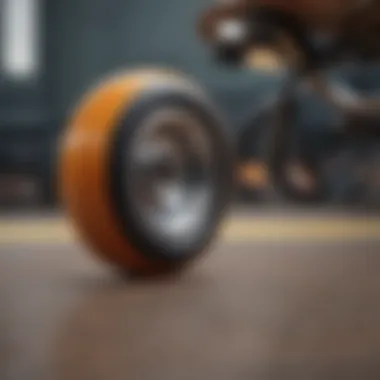Which Longboard is Right for Me? A Comprehensive Guide


Intro
Selecting the right longboard is not just a matter of preference; it is a nuanced decision influenced by various factors. This guide aims to assist you in understanding those factors, ultimately enabling an informed choice tailored to your specific needs. Whether you are a novice just starting or an experienced rider looking for a change, knowing the various elements involved in longboarding can significantly influence your riding experience.
Longboarding, as a sport, has evolved dramatically over the years. Understanding its history can provide context for your longboard selection process. Additionally, being aware of the types of longboards, their specifications, and how they align with different riding styles is critical. Safety, performance, and enjoyment all hinge on making thoughtful decisions regarding your equipment.
In this comprehensive guide, we will explore types of longboards, key specifications, and specific factors to consider based on your riding conditions. You will gain insights into materials, deck shapes, wheel sizes, and much more. This will empower you to select the ideal longboard that enhances both your safety and your performance.
Let's embark on this exploration to discover the best longboarding options available.
Understanding Longboarding Basics
Longboarding can be an intriguing sport, rich with its unique culture and elements. Understanding the basics is essential before diving into the world of longboards. It lays the foundation for making informed decisions. Knowledge of these concepts grants riders better control and enjoyment while participating in longboarding.
What is Longboarding?
Longboarding is a variation of skateboarding that features longer decks and varied designs, enabling distinct riding styles. The boards are typically between 33 to 59 inches long, offering increased stability and a smoother ride, especially at higher speeds. Longboarding focuses not just on tricks but also on cruising, carving, commuting, and downhill racing. This sport promotes a sense of freedom and movement, allowing riders to explore their surroundings in unique ways.
Key Differences Between Longboards and Skateboards
While both longboards and skateboards are popular among riders, they have significant differences.
- Length and Design: Longboards are longer and wider than traditional skateboards. This design enables better stability and glide, making it suitable for various terrains.
- Purpose: Skateboards are more trick-oriented, designed for flips and stunts in skate parks. Longboards cater to cruising, downhill rides, and long-distance travel.
- Trucks and Wheels: Longboards typically have softer wheels that absorb shocks better on rough surfaces, while skateboards have harder wheels suitable for slick surfaces in skate parks.
Understanding these differences is crucial for choosing a board that resonates with one’s riding preferences and styles.
Common Longboarding Terminology
Familiarity with longboarding terminology enhances communication within the community and improves understanding of gear and techniques. Here are a few common terms:
- Deck: The flat part of the board where riders stand.
- Trucks: The metal parts that connect the wheels to the deck and allow turning.
- Wheels: The round components that provide mobility. They come in various sizes and hardness ratings.
- Grip Tape: A gritty surface on top of the deck for traction.
By learning these fundamental terms, riders can navigate discussions about gear and help facilitate an improved longboarding experience.
Types of Longboards
Understanding the various types of longboards is essential when selecting the right one for your needs. Each type serves a distinct purpose and addresses specific riding styles. Knowing these types will help you make informed decisions that amplify your performance and enjoyment on the board.
Cruisers
Cruiser longboards are designed primarily for casual riding. They are ideal for those who navigate through urban streets or enjoy leisurely rides along the beach. These boards typically feature a wider deck, which provides enhanced stability while carving through turns. The wheels on cruiser longboards are often softer than those found on other types, affording a smoother ride over rough surfaces. The lightweight design make them easy to carry around as well. This makes cruisers a suitable choice for beginners or anyone looking for an easy-going ride.
Freeride Longboards
Freeride longboards are categorized by their ability to allow riders to perform tricks and slides with greater ease. They often have symmetrical shapes, making it easy to ride in either direction. These boards are built with durability in mind and often feature a sturdier deck to withstand the stresses of tricks. Many freeride longboards come with griptape for better traction. The versatility they offer makes them popular among intermediate to advanced riders who like to experiment with various tricks and maneuverability.
Downhill Longboards


Downhill longboards are specifically engineered for high-speed rides down slopes. The design focuses on aerodynamics and stability. These boards typically have a low center of gravity and a wider wheelbase, which enhances stability at high speeds. Riders often find that downhill longboards have harder wheels. This combination minimizes wobbling and maintains speed. Enthusiasts who seek the adrenaline rush of speed will find this type appealing. However, it is vital to have the skills to manage such speeds effectively.
Pintails and Mini Longboards
Pintail longboards are characterized by their elongated shape and pointed nose and tail. They are often used for cruising and are especially popular for beginners. The design allows for sharp turns, making them agile for navigating through tight spots. Mini longboards, on the other hand, are compact versions designed for portability. They are lightweight and easier to maneuver, making them a good option for short commutes or traversing crowded areas. The choice between these two often depends on personal preference regarding size and style.
Electric Longboards
Electric longboards have gained popularity due to their convenience and ease of use. Equipped with motors, these boards allow riders to travel longer distances without the physical exertion of traditional longboarding. This makes them particularly appealing for commuters or those looking to explore longer trails. They come equipped with controls for speed and braking, offering a different kind of riding experience. However, it's essential to adhere to local regulations regarding their use, as laws may vary greatly.
Choosing the right type of longboard is paramount for anyone looking to enhance their riding experience. Each type offers unique features tailored to specific riding styles and preferences. Arm yourself with this knowledge before making a purchase, and your longboarding journey will likely be more enjoyable.
Choosing the Right Longboard
Selecting a longboard that suits your individual needs is crucial for enhancing both your riding experience and safety. With the diverse range of options available, understanding your personal requirements will lead you to the most suitable choice.
By focusing on specific elements such as your riding style, the conditions in which you intend to ride, and your current skill level, you can ensure that the longboard you select will provide optimal performance and enjoyment. An informed decision not only impacts your immediate riding experience but also plays a significant role in your progress and confidence as a rider.
Consider Your Riding Style
Riding style is perhaps the most vital factor when choosing a longboard. Your style will dictate the type of board that fulfills your needs.
- Cruising: If you enjoy leisurely rides around town or commuting, consider a cruiser longboard. These boards typically feature wider decks and softer wheels that enhance comfort and stability.
- Freeride: For those who like to slide or perform tricks, a freeride longboard is ideal. These boards balance stability and maneuverability.
- Downhill: If speed is your passion, then a downhill longboard will serve you well. They tend to be longer and lower to the ground, providing better control at high velocities.
Understanding your riding style aids in selecting a longboard tailored to how you most enjoy riding. This can make all the difference in your experience.
Assess Riding Conditions
The terrain on which you will ride is a decisive aspect of longboard selection. Different boards accommodate varied riding conditions.
- Smooth Pavements: For smoother surfaces, you can opt for longboards with larger wheels that give better grip and speed.
- Rough Terrains: If your rides often take you over challenging surfaces, consider a board with robust wheels and a flexible deck. This can absorb shocks better and improve your riding comfort.
An analysis of the riding conditions you expect to encounter allows you to choose a longboard that will perform well in those environments, reducing risks and enhancing fun.
Identify Skill Level
Your skill level substantially influences your choice of longboard. A beginner may benefit more from a board that offers stability and ease of use. Advanced riders, however, might prefer boards that provide agility and enough challenge to facilitate skill growth.
- Beginners: A wider deck and softer wheels can help new riders gain confidence as they learn to balance and steer. Boards such as the Arbor Axis Bamboo Longboard are often recommended for entry-level riders.
- Intermediate and Advanced Riders: These riders may seek out boards with finer specifications that allow for tricks and high-speed stability. The Loaded Tan Tien is a popular choice among those looking to push their skills further.
By identifying your skill level, you can select a longboard that not only matches your current abilities but also encourages your development as a rider.
Longboard Specifications
Understanding longboard specifications is crucial for making an informed choice. The specifications influence how the board feels, responds to different terrains, and suits individual riding styles. There are several key components to consider, including the materials used for the deck, the shapes and sizes available, truck options, and wheels. Each of these elements contributes to a tailored longboarding experience and can affect performance and safety.
Deck Materials


Choosing the right deck material can significantly influence the ride and handling of a longboard.
Wood
The most traditional longboard material is wood. Typically, maple is common due to its strength and flexibility. Wood has a good natural feel and offers a solid ride. Its natural properties provide a damping effect, absorbing shock from bumps in the road. A key characteristic of wood is its ability to flex, which enhances control while riding. However, wood can be less durable compared to other materials, particularly when exposed to moisture. Thus, proper care is essential.
Fiberglass
Fiberglass is another popular material utilized in longboard construction. It is lightweight yet strong, allowing for a snappier ride. The use of fiberglass can create a more responsive board compared to traditional wood. A significant advantage is its resistance to warping and damage over time, adding longevity. However, fiberglass decks are generally less forgiving on rough terrains as they do not absorb impacts as well as wood does.
Carbon Fiber
Carbon fiber is known for its high strength-to-weight ratio. This material is a favorite among performance enthusiasts who desire lightweight and durable boards. Carbon fiber decks provide excellent stiffness, which leads to a more responsive feel during fast turns. While it is a high-performance option, its cost is often significantly higher than wood or fiberglass. Thus, it may not be the best choice for beginners or casual riders.
Deck Shapes and Sizes
The shape and size of a deck also play a fundamental role in longboard performance.
Concave vs Flat
Concave decks feature a slight curve that helps to better grip the rider’s feet. This design enhances control, especially during turns or tricks. Conversely, flat decks provide more surface area for foot placement, which can be appealing for novice riders. However, flat decks might lack the locked-in feeling that concave boards provide, impacting overall stability at high speeds.
Length Considerations
Length is a crucial factor that affects stability and maneuverability. Longer boards typically offer more stability at high speeds, making them suitable for downhill rides. Shorter boards, however, are easier to maneuver and ideal for more technical tricks or city riding. A common recommendation is to select a board length tailored to riding style and comfort level.
Width Variations
Width variations affect how the board responds under various loads. Wider boards give greater stability, particularly for riders over a certain weight. A narrow board allows for more agility but may compromise stability. It is essential to choose a width that matches your foot size and riding style, thus enhancing your control while riding.
Truck Options
Trucks influence how a longboard performs in turns, stability, and overall handling.
Width and Height
The width of the trucks should match the deck width for optimal performance. Wider trucks provide stability, while narrower trucks can enhance agility. Height can also affect ride characteristics. Lower trucks reduce the board’s center of gravity, adding stability, while higher trucks increase turning capabilities.
Material Choices
The most common materials for trucks include aluminum and steel. Aluminum trucks are lightweight and typically provide good performance for most riders. Steel can be heavier but adds durability, which might be preferable for downhill riders or those who ride aggressively.
Wheel Selection
Wheels are vital as they affect ride quality and grip.
Durometer Ratings


Durometer ratings indicate wheel hardness. Softer wheels provide better grip and a smoother ride on rough surfaces. They are beneficial for beginners or those riding in urban settings. Harder wheels, while faster on smooth surfaces, offer less grip, which can be a disadvantage on rough terrains.
Diameter Choices
Wheel diameter affects ride speed and control. Smaller wheels tend to be more responsive but may not roll over obstacles well. Larger wheels offer smoother rides and can handle rough terrains better. The right diameter choice depends on the riding style and surface conditions.
Material and Shape Variations
Wheels can vary in shape and material, impacting how they perform and feel on the road. Common materials include urethane, known for its durability and grip. Wheel shapes, such as square-edged versus round-edged designs, influence traction and slide-ability during maneuvers. Each variation presents its advantages and disadvantages, highlighting the importance of selecting suitable components for specific riding environments.
Safety and Accessories
When it comes to longboarding, safety and accessories play a crucial role in ensuring both protection and performance. The right gear can make the difference between an enjoyable ride and an unfortunate accident. As riders take to various terrains, it becomes vital to prioritize safety by investing in appropriate protective gear. Furthermore, accessories enhance the longboarding experience, making it easier to transport and maintain the longboard.
Protective Gear Essentials
Helmets
Helmets are arguably the most important type of protective gear for longboarding. They protect the head from severe injuries during falls. A well-fitted helmet absorbs impacts, helping to reduce the risk of concussions or skull fractures. Many brands offer helmets with features such as adjustable straps and ventilation systems, which keep the wearer comfortable while riding. Investing in a high-quality helmet is beneficial as it can save lives.
Unique features of modern helmets include MIPS technology, which redirects energy and reduces rotational forces during certain impacts. Unfortunately, some riders may find helmets restrictive, and they can be tempting to skip, especially in warm weather. Nonetheless, wearing a helmet while riding can significantly enhance safety.
Kneepads
Kneepads provide essential lower body protection, covering one of the most vulnerable areas during a longboarding fall. They come in various styles and materials, allowing riders to choose based on their preferences and riding style. The primary characteristic of quality kneepads is their ability to absorb impact while allowing freedom of movement. This makes them a popular choice for both novice and experienced riders.
A unique feature of many kneepads is their adjustable straps, which ensure a snug fit. However, some kneepads can be bulky and may cause discomfort during extended rides. Despite this, the protection they offer is often worth the trade-off for serious riders.
Elbow Pads
Elbow pads serve a similar purpose as kneepads, protecting the elbows from scrapes and bruises. They are important for riders who frequently practice tricks or descend steep hills. The main characteristic of elbow pads is their cushioning and their ability to stay in place during rides. Many riders prefer soft-shell elbow pads for flexibility and comfort.
Elbow pads often include hard caps to absorb impacts, providing an added layer of protection. However, they can be less breathable compared to other protective gear. Even so, the assurance of extra safety makes them a valuable investment for any longboarding enthusiast.
Additional Longboarding Accessories
Riding Shoes
Riding shoes are specially designed footwear that helps maximize grip and control. They usually feature a flat sole and a snug fit, which allows the rider to maintain balance and stability on the board. The key characteristic is the slip-resistant material used on the soles, making them a popular choice among longboarders.
The unique feature here is the ability of these shoes to provide direct contact with the board without interference. On the downside, some shoes may lack adequate arch support, leading to discomfort during long rides. Despite this, many riders appreciate the enhanced control these shoes offer during maneuvers.
Carrying Cases
Carrying cases are crucial for transporting longboards safely. These cases come in various sizes, fitting different board types and styles. Their main characteristic is their padded protection, which ensures that the board remains unharmed during transit. Many riders find them beneficial as they prevent damage from bumps and scratches.
A unique feature of good carrying cases is the ability to accommodate extra accessories. However, some cases can be bulky and heavy, making them less ideal for those who prefer minimalism in transport. Still, for serious longboarders, these cases provide peace of mind during travel.
Maintenance Tools
Maintenance tools are essential for keeping a longboard in top condition. These tools include screwdrivers, skate tool kits, and lubricant for the bearings. Their primary characteristic is functionality, allowing riders to perform basic repairs and adjustments easily. This is especially important for those who ride frequently, as regular maintenance prolongs the life of the board.
Unique features may include compact tool kits that are easy to carry. However, some tools can be complex to use for beginners. Despite the learning curve, understanding maintenance is crucial in ensuring safety and optimal performance.
Prioritizing safety gear and accessories not only enhances your riding experience but also safeguards against potential accidents.



